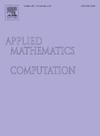Disjoint path covers of star graphs
IF 3.5
2区 数学
Q1 MATHEMATICS, APPLIED
引用次数: 0
Abstract
Given a graph G, let S and T be two vertex-disjoint subsets of equal size k of G. A k-disjoint path cover of G corresponding to S and T is the union of k vertex-disjoint paths among S and T that spans G. If every vertex of S should be joined to a prescribed vertex in T, it is defined to be paired, otherwise it is unpaired. Let be a star graph with bipartition and . Let and be two vertex subsets of equal size k. It is shown in this paper that admits an unpaired k-disjoint path cover between S and T, where and . In view of the degree of , this result is optimal.
星形图的相邻路径覆盖
给定一个图 G,设 S 和 T 是 G 的两个大小相等的 k 个顶点相交子集。与 S 和 T 相对应的 G 的 k 个相交路径覆盖是 S 和 T 之间跨越 G 的 k 个顶点相交路径的联合。假设 STn 是一个星形图,具有双分区 V0 和 V1。本文证明了 STn 在 S 和 T 之间允许一个非配对的 k 叉路径覆盖,其中 k≤n-2 且 n≥4。考虑到 STn 的度数,这一结果是最优的。
本文章由计算机程序翻译,如有差异,请以英文原文为准。
求助全文
约1分钟内获得全文
求助全文
来源期刊
CiteScore
7.90
自引率
10.00%
发文量
755
审稿时长
36 days
期刊介绍:
Applied Mathematics and Computation addresses work at the interface between applied mathematics, numerical computation, and applications of systems – oriented ideas to the physical, biological, social, and behavioral sciences, and emphasizes papers of a computational nature focusing on new algorithms, their analysis and numerical results.
In addition to presenting research papers, Applied Mathematics and Computation publishes review articles and single–topics issues.

 求助内容:
求助内容: 应助结果提醒方式:
应助结果提醒方式:


